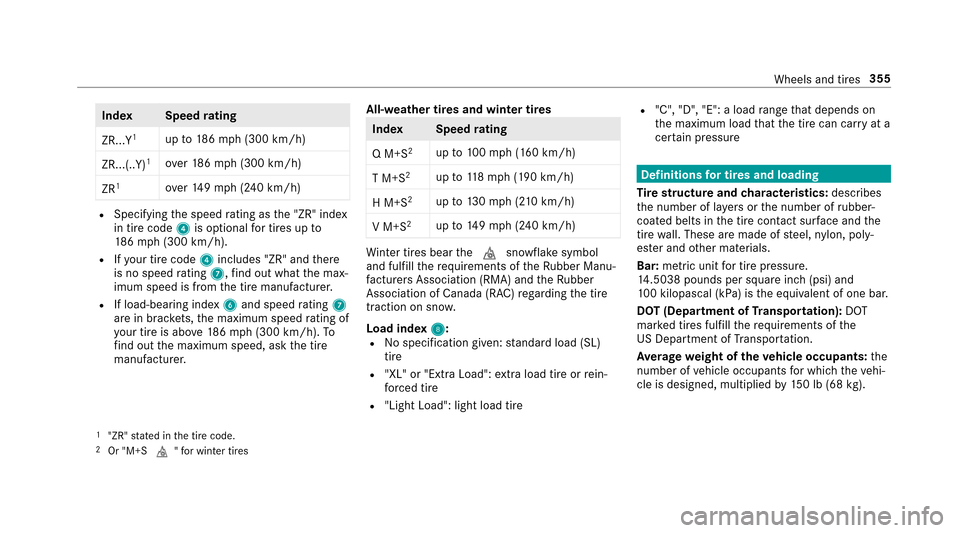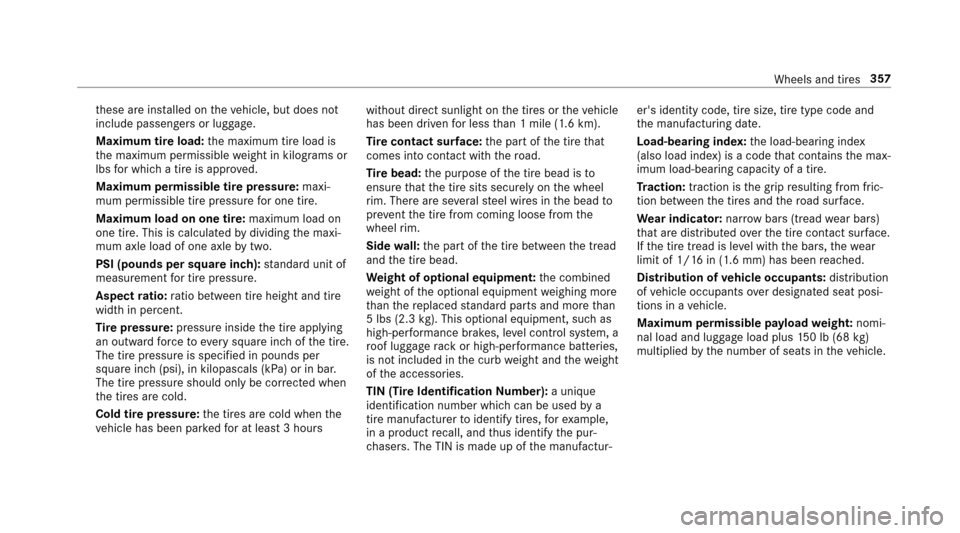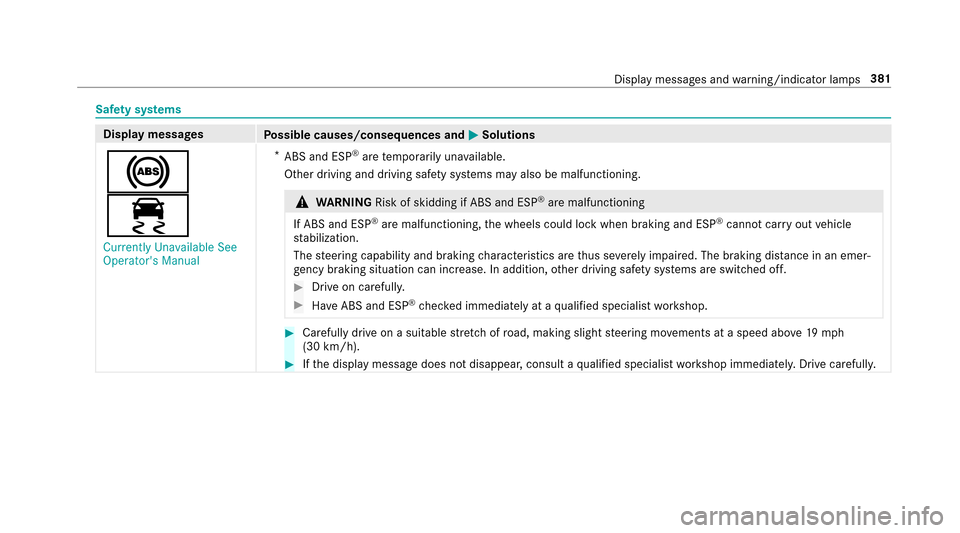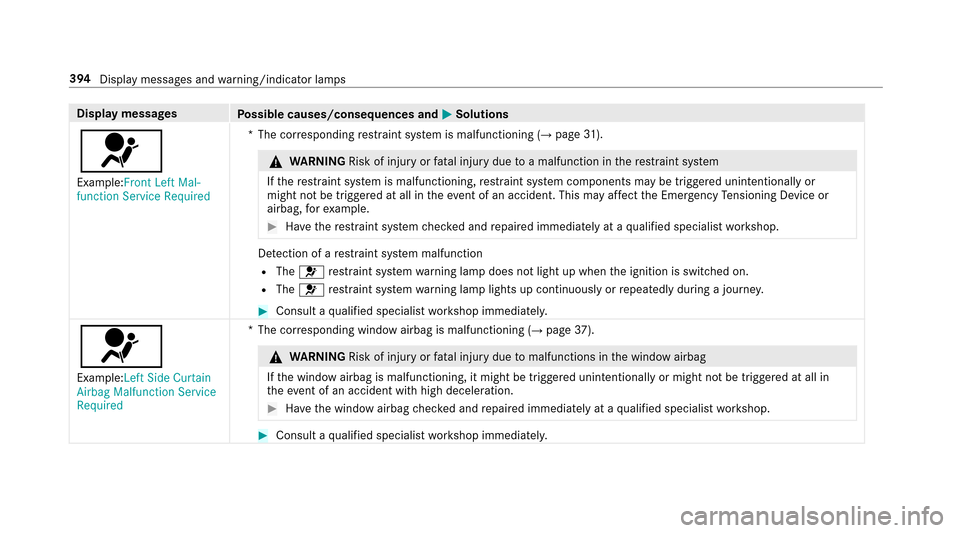Page 357 of 482

IndexS peedrating
ZR...Y
1up to186mp h(3 00 km/h)
ZR...(..Y)
1ove r18 6mp h(3 00 km/h)
ZR
1ove r14 9mp h (240 km/h)
RSpecifying the speed rating as the "ZR" index
in tire code 4is optional for tires up to
18 6mp h(3 00 km/h).
RIfyo ur tire co de4 includes "ZR"andthere
is no speed rating 7,find out what the max‐
imum speed is from the tire manufacturer.
RIf load-bearing index 6and speed rating 7
are in brac kets, the maximum speed rating of
yo ur tire isabo ve186mp h (300 km/h). To
fi nd out the maximum speed, ask the tire
manufacturer. All-weather tires and winter tires
Inde
xS peedrating
Q M+S
2up to100mp h (160 km/h)
T M+S
2up to118mp h(190 km/h)
H M+S
2up to130mp h (2 10km/h)
V M+S
2up to149mp h (240 km/h)
Winter tires bear thei snowflake symbol
and fulfill therequ irements of theRu bber Manu‐
fa cturers Association (RMA) and theRu bber
Association of Canada (RAC) rega rding the tire
traction on sno w.
Load index 8
:RNo specification given: standard load (SL)
tire
R"XL" or "Extra Load": extra load tire or rein‐
fo rc ed tire
R"Light Load": light load tire
R"C", "D", "E": a load range that depends on
th e maximum load that the tire can car ryat a
cer tain pressure
Definitions for tires and loading
Ti re stru ctureand characteristics: describes
th e number of la yers or the number of rubber-
coated belts in the tire conta ct surface and the
tire wall. These are made of steel, nylon, poly‐
es ter and other materials.
Bar: metric unit for tire pressure .
14 .5038 pounds per square inch (psi) and
10 0 kilopascal (kPa) is the equivalent of one bar.
DOT (Department of Transport ation):DOT
mar ked tires fulfill therequ irements of the
US Department of Transpor tatio n.
Av erage weight of theve hicle occupants: the
number of vehicle occupants for which th eve hi‐
cle is designed, multiplied by150 lb (68 kg).
1"ZR" stated in the tire code.2Or "M+S i"for winter tires
Wheels and tires 355
Page 359 of 482

these are ins talled on theve hicle, but does not
include passengers or luggage.
Maximum tire load: the maximum tire load is
th e maximum permissible weight in kilog rams or
lbs for which a tire is appr oved.
Maximum permissible tire pressure: maxi‐
mum permissible tire pressure for one tire.
Maximum load on one tire: maximum load on
one tire. This is calculated bydividing the maxi‐
mum axle load of one axle bytwo.
PSI (pounds per square in ch):standard unit of
measurement for tire pressure .
Aspect ratio: ratio between tire height and tire
width in pe rcent.
Ti re pressure: pressure inside the tire applying
an outward forc eto eve rysquare inch of the tire.
The tire pressure is specified in pounds per
square inch (psi), in kilopascals (kPa) or in bar.
The tire pressure should only be cor rected when
th e tires are cold.
Cold tire pressure: the tires are cold when the
ve hicle has been par kedfo r at least 3 hours without direct sunlight on
the tires or theve hicle
has been driven for less than 1 mile (1.6 km).
Ti re contact sur face: the part of the tire that
comes into con tact wi th thero ad.
Ti re bead: the purpose of the tire bead is to
ensure that the tire sits securely on the wheel
ri m. There are se veralst eel wires in the bead to
pr eve nt
the t
ire from coming loose from the
wheel rim.
Side wall:the part of the tire between the tread
and the tire bead.
We ight of optional equipment: the combined
we ight of the optional equipment weighing more
th an there placed standard parts and more than
5 lbs (2.3 kg).This optional equipment, such as
high-per form ance brakes, le vel control sy stem, a
ro of luggage rack or high-per form ance batte ries,
is not included in the curb weight and thewe ight
of the accessories.
TIN (Tire Identification Number): a unique
identification number which can be used bya
tire manufactu rerto identify tires, forex ample,
in a product recall, and thus identify the pur‐
ch asers. The TIN is made up of the manufactur‐ er's identity code, tire size, tire type code and
th
e manufacturing date.
Load-bearing index: the load-bearing index
(also load index) is a code that con tains the max‐
imum load-bearing capacity of a tire.
Tr action: traction is the grip resulting from fric‐
tion between the tires and thero ad sur face.
We ar indicator: narrow bars (tread wear bars)
th at are distributed overth e tire conta ct surface.
If th e tire tread is le vel with the bars, thewe ar
limit of 1/ 16in (1.6 mm) has been reached.
Distribution of vehicle occupants: distribution
of vehicle occupants
over design
ated seat posi‐
tions in a vehicle.
Maximum permissible pa yload weight: nomi‐
nal load and luggage load plus 150 lb (68 kg)
multiplied bythe number of seats in theve hicle.
Wheels and tires 357
Page 379 of 482

#Make surethat no windshield washer
concentrate spills out next tothefiller
opening.
* NO
TEDama getotheex terior lighting
due tounsuit able wind shieldwasher fluid
Uns uitable wind shieldwasher fluid may dam‐
age the plastic sur face of theex terior light‐
ing.
#Only use windshield washer fluid whic h
is also suitable for use on plast ic surfa‐
ces, e.g. MB SummerFit or MB Winter‐
Fit.
* NO
TEBlocked spr aynozzles caused by
mixing windshield washer fluids
#Do not mix MB SummerFit and MB Win‐
te rFit with other windshield washer flu‐
ids.
Do not use distilled or de-ionized water asthefill
le ve l sensor may be triggered er roneously. Re
commended windshield washer fluid:
RAbo vefreezing point: e.g. MB SummerFit
RBelow freezing point: e.g. MB WinterFit
Fo rth e cor rect mixing ratio referto the informa‐
tion on the antif reeze reser voir.
Ad d windshield washer fluid tothewa sher water
all year round.
Re frigerant
Note s onrefrigerants
Obser vethe no tes on operating fluids
(
→page 372).
* NO
TEDama gedue toincor rect refriger‐
ant
If a non-appr ovedre frigerant is used, the cli‐
mate control sy stem may be damaged.
#Only use there frigerant R‑134a
* NO
TEDama getothe climate control
sy stem due toincor rect refrigerant com‐
pressor oil
#Only use refrigerant compressor oil that
has been appr ovedby Mercedes-Benz.
#Do not mix the appr ovedre frigerant
compressor oil with a dif fere nt refriger‐
ant compressor oil.
Wo rkon the climate control sy stem may only be
car ried out byaqu alified specialist workshop. All
applicable regulations, as well as SAEstandard
J639, must be adhered to.
Te ch nical da ta37
7
Page 383 of 482

Safety sy stems
Display messages
Possible causes/consequences and MSolutions
!
÷
�&�X�U�U�H�Q�W�O�\ �8�Q�D�Y�D�L�O�D�E�O�H �6�H�H
�2�S�H�U�D�W�R�U�
�V �0�D�Q�X�D�O*
ABS and ESP
®are temp orarily una vailable.
Other driving and driving saf etysy stems may also be malfunctioning.
&
WARNING Risk of skidding if ABS and ESP®are malfunctioning
If ABS and ESP
®are malfunctioning, the wheels could lock when braking and ESP®cannot carryout vehicle
st abilization.
The steering capability and braking characteristics are thus se verely impaired .Th ebr aking dis tance in an emer‐
ge ncy braking situation can increase. In addition, other driving saf etysy stems are switched off.
#Drive on carefull y.
#Have ABS and ESP®checked immediately at a qualified specialist workshop.
#Carefully drive on a suitable stre tch of road, making slight steering mo vements at a speed abo ve19 mp h
(30 km/h).
#If th e display message does not disappear, consult a qualified specialist workshop immediately. Drive carefully.
Display messages and warning/indicator lamps 381
Page 385 of 482
Displaymessages
Possible causes/consequences and MSolutions
÷
�&�X�U�U�H�Q�W�O�\ �8�Q�D�Y�D�L�O�D�E�O�H �6�H�H
�2�S�H�U�D�W�R�U�
�V �0�D�Q�X�D�O*
ESP
®is temp orarily una vailable.
Other driving and driving saf etysy stems may also be malfunctioning.
&
WARNING Risk of skidding if ESP®is malfunctioning
If ESP
®is malfunctioning, ESP®cannot car ryout vehicle stabilization. In addition, other driving saf etysy stems
are switched off.
#Drive on carefull y.
#Have ESP®checked at a qualified specialist workshop.
#Carefully drive on a suitable stre tch of road, making slight steering mo vements at a speed abo ve19 mp h
(30 km/h).
#If th e display message does not disappear, consult a qualified specialist workshop immediately. Drive carefully.
Display messages and warning/indicator lamps 383
Page 395 of 482
Displaymessages
Possible causes/consequences and MSolutions
6
�6�5�6 �0�D�O�I�X�Q�F�W�L�R�Q �6�H�U�Y�L�F�H
�5�H�T�X�L�U�H�G*T
herestra int sy stem is malfunctioning (
→page 31).
&
WARNING Risk of injury orfata l injury due toa malfunction in there stra int sy stem
If th ere stra int sy stem is malfunctioning, restra int sy stem components may be triggered unintentionally or
might not be triggered at all in theeve nt of an accident. This may af fect the Emer gency Tensioning Device or
airbag, forex ample.
#Ha ve there stra int sy stem checked and repaired immediately at a qualified specialist workshop.
Re cognizing a restra int sy stem malfunction
RThe restra int sy stem warning lamp 6does not light up when the ignition is switched on.
RThe restra int sy stem warning lamp 6lights up continuously or repeatedly during a journe y.
#Visit a qualified specialist workshop immediatel y.
Displaymessage s andwarning/indicator lamps 393
Page 396 of 482

Displaymessages
Possible causes/consequences and MSolutions
6
Example:�)�U�R�Q�W �/�H�I�W �0�D�O��
�I�X�Q�F�W�L�R�Q �6�H�U�Y�L�F�H �5�H�T�X�L�U�H�G*T
he cor responding restra int sy stem is malfunctioning (
→page 31).
&
WARNING Risk of injury orfata l injury due toa malfunction in there stra int sy stem
If th ere stra int sy stem is malfunctioning, restra int sy stem components may be triggered unintentionally or
might not be triggered at all in theeve nt of an accident. This may af fect the Emer gency Tensioning Device or
airbag, forex ample.
#Ha ve there stra int sy stem checked and repaired immediately at a qualified specialist workshop.
De tection of a restra int sy stem malfunction
RThe 6 restra int sy stem warning lamp does not light up when the ignition is switched on.
RThe 6 restra int sy stem warning lamp lights up continuously or repeatedly during a journe y.
#Consult aqualified specialist workshop immediatel y.
6
Example:�/�H�I�W �6�L�G�H �&�X�U�W�D�L�Q
�$�L�U�E�D�J �0�D�O�I�X�Q�F�W�L�R�Q �6�H�U�Y�L�F�H
�5�H�T�X�L�U�H�G *T
he cor responding window airbag is malfunctioning (
→page 37).
&
WARNING Risk of injury orfata l injury due tomalfunctions in the window airbag
If th e window airbag is malfunctioning, it might be triggered unintentionally or might not be triggered at all in
th eeve nt of an accident wi thhigh deceleration.
#Ha ve the window airbag checked and repaired immediately at a qualified specialist workshop.
#Consult a qualified specialist workshop immediatel y.
394
Display messages and warning/indicator lamps
Page 423 of 482
Lights
Display messagesPossible causes/consequences and MSolutions
b
Example:�&�K�H�F�N �/�H�I�W �/�R�Z
�%�H�D�P*T
he cor responding light source is defective.
#Visit a qualified specialist workshop.
% LED light bulbs: the display message forth e cor responding lamp only appears when allthe light-emitting diodes
in the lamp ha vefailed.
b
�$�F�W�L�Y�H �+�H�D�G�O�D�P�S�V �,�Q�R�S�H�U�D��
�W�L�Y�H *T
he active light function is malfunctioning.
#Consult a qualified specialist workshop.
b
�0�D�O�I�X�Q�F�W�L�R�Q �6�H�H �2�S�H�U�D��
�W�R�U�